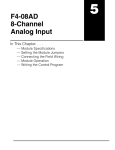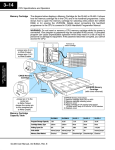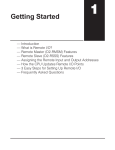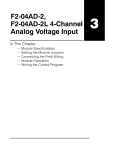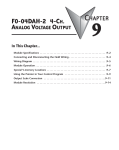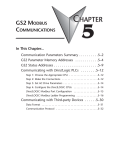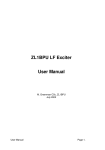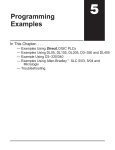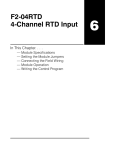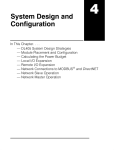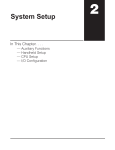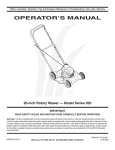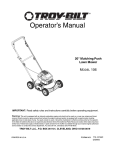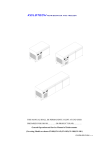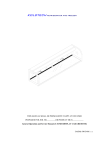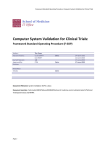Download Chapter 3 - AutomationDirect
Transcript
F4–04AD 4-Channel Analog Input In This Chapter. . . . 3 Ċ Module Specifications Ċ Setting the Module Jumpers Ċ Connecting the Field Wiring Ċ Module Operation Ċ Writing the Control Program, 16 Input Mode Ċ Writing the Control Program, 32 Input Mode Ċ Scaling and Converting the Input Data Ċ Configuration CrossĆReference, D4-04AD to F4-04AD 3–2 F4–04AD 4-Channel Analog Input F4–04AD 4-Ch. Analog Input Module Specifications The F4-04AD Analog Input module provides several features and benefits. S It is a direct replacement for the popular D4-04AD module, when properly configured. S It accepts four differential voltage or current inputs. S Analog inputs are optically isolated from PLC logic components. S The module has a removable terminal block, so the module can be easily removed or changed without disconnecting the wiring. S All four analog inputs may be read in one CPU scan (DL440/450 CPUs only). S Broken transmitter detection is provided for current inputs. ANALOG INPUT TB 1 2 4 8 24V DATA 16 32 64 128 RUN NEG 256 512 1024 2048 CH1 CH2 CH3 CH4 F4–04AD DISPLAY CH V C CH1 I OV V C CH2 I OV V C CH3 I OV V C CH4 I OV 0–10VDC 1–5VDC –10–+10VDC 4mA–20mA 24VDC 0.1A CLASS 2 F4–04AD NOTE: If you are replacing a D4–04AD with a F4–04AD in an existing application, make sure to read the last section in this chapter, “Configuration Cross-Reference, D4–04AD to F4–04AD.” Analog Input Configuration Requirements The F4–04AD Analog Input module requires either 16 or 32 discrete input points, depending on its operating mode (jumper selectable). The module can be installed in any slot of a DL405 system, including remote bases. The limitations on the number of analog modules are: S For local and expansion systems, the available power budget and discrete I/O points are the limiting factors. S For remote I/O systems, the available power budget and number of remote I/O points are the limiting factors. Check the user manual for your particular model of CPU for more information regarding power budget and number of local or remote I/O points. F4–04AD 4 Channel Analog Input 3–3 The following tables provide the specifications for the F4-04AD Analog Input Module. Review these specifications to ensure the module meets your application requirements. Input Specifications 4 Input Type Single-ended or differential Input Ranges 0–5, 1–5, 0–10, $5, $10 VDC, 0–20, 4–20 mA. Resolution 12 bit (0 to 4095), unipolar 13 bit ($4095), bipolar Input Impedance 20 MΩ minimum, voltage input 250 Ω, 1/2W, $0.1%, 25 ppm/_ C current input Max. Continuous Overload $50 VDC, voltage input, $45 mA, current input Recommended External Fuse 0.032A, Series 217 fast acting, current inputs Common Mode Voltage Range $10V maximum Linearity $0.025% of span ($1 count maximum, unipolar) Input Stability $1/2 count Cross Talk –80 dB, 1/2 count maximum Full Scale Calibration Error $12 counts maximum, voltage input $16 counts maximum, at 20.000 mA current input Offset Calibration Error $1 count maximum, voltage input $2 counts maximum, at 4.000 mA current input Maximum Inaccuracy 0.4% maximum @ 25_C (77° F) 0.55% maximum @ 0 to 60_C (32 to 140° F) Conversion Time < 6 mS per selected channel Noise Rejection Ratio Normal mode: –3 dB @ 50 Hz, –6 dB / octave Common mode: –70 dB, DC to 12 kHz PLC Update Rate 4 channel per scan max. Digital Input Points Required 16 or 32-bit mode 16 or 32 (X) input points 12 data bits, 4 bits optional for two’s complement mode, 4 channel select bits, 12 bits unused in 32 bit mode Power Budget Requirement 85 mA (power from base) External Power Supply 24 VDC, $10%, 100 mA, class 2 Operating Temperature 0 to 60_C (32° to 140° F) Storage Temperature –20 to 70_C (–4° to 158° F) Relative Humidity 5 to 95% (non-condensing) Environmental air No corrosive gases permitted Vibration MIL STD 810C 514.2 Shock MIL STD 810C 516.2 Insulation Resistance 10 MΩ, 500 VDC Noise Immunity NEMA ICS3-304 F4–04AD 4-Ch. Analog Input General Specifications Number of Channels 3–4 F4–04AD 4-Channel Analog Input Setting the Module Jumpers Jumper Locations The module has several options that you can select by installing or removing jumpers. At the rear of the module is a bank of eight jumpers. They may be configured to select either 16 Input Mode or 32 Input Mode operation, input range selection, units of measurement selection and the number of channels enabled. Jumper Descriptions (located below jumper on PC board) Functional Descriptions 2 16 or 32 Input Mode on=32 1 0 Range 2 1 0 1 0 Units 1 CHN 1 0 F4–04AD 4-Ch. Analog Input Range 0 1 0 Units Active Channels Jumper Descriptions NOTE: If you are replacing a D4–04AD module with the F4–04AD in an existing application, skip to the special section at the end of this chapter, “Configuration Cross-Reference, D4–04AD to F4–04AD”. Factory Default Settings By default, the module arrives from the factory with all jumpers installed. With all jumpers installed, the module has four active channels, is in 32 Input Mode, has 4 to 20 mA. input range, and the units of the data are 12-bit (0 to 4095) BCD numbers. Selecting the Number of Active Channels The F4-04AD module accepts from one to four analog inputs and converts the signal(s) to a desired format to send to the CPU. The bottom two jumpers (J7 and J8) select the number of channels enabled. The module only converts signals on channels that are enabled. If your application requires less than four signal inputs from this module, selecting fewer channels results in faster update times. Use the following table to set jumpers. = jumper removed = jumper installed 1 0 Number of Active Channels 3–5 F4–04AD 4 Channel Analog Input Channel(s) Selected Selecting 16 Input or 32 Input Modes Jumper Settings Channel 1 1 0 Channel 1, Channel 2 1 0 Channel 1, Channel 2, Channel 3 1 0 Channel 1, Channel 2, Channel 3, Channel 4 1 0 The top jumper selects either 16 Input (remove jumper) or 32 Input (install jumper) operating modes. This is the number of X inputs the module requires in the PLC memory map. The module can interface to the CPU in two different ways, depending on the setting of this jumper. Use 32 Input mode if you want to maintain compatibility with PLC software written for the D4-04AD, or to use features not available in 16 Input mode, and to simplify supporting ladder logic. However, use 16 Input Mode if you must consume fewer X inputs. The feature chart on the next page can help you choose the mode for your application. Jumper Remove Install F4–04AD 4-Ch. Analog Input Mode 16 Input 32 Input Mode Select Jumper I/O Points Consumed X0 – X17 X0 – X37 Features 16 Input Mode 32 Input Mode Number of X Input Bits Required From CPU 16 32 Input Value, 12-Bit, Plus Sign Bit Yes Yes Input Value, 2’s Complement,12 Bits No Yes Input Value, 2’s Complement, 13 Bits No Yes Input Value, 12-bit Yes Yes Input Value, Binary-Coded Decimal, 16 bits (for bipolar voltage ranges only) No Yes Active Channel Indicator Inputs Yes Yes Broken Transmitter Detection 1 bit (combined) 4 bits (individual) Sign Bit(s), indicates negative analog value 1 bit (combined) 4 bits (individual) Based on this jumper selection, the module can behave as two different modules from the CPU point of view. This chapter covers both modes, so only the CPU program examples labeled for the mode you choose will apply. 3–6 F4–04AD 4-Channel Analog Input Operating Range Selection 16 Input Mode These three jumpers select the voltage or current range for all four input channels simultaneously. The type of input (voltage or current) is actually determined by user wiring to specific terminals on the front connector. Along with proper wiring, set these jumpers for the desired voltage or current signal range. The three jumpers are binary encoded to offer eight possible settings. 2 1 0 Range Select Jumpers More input ranges are available for the module’s 32 Input mode than for 16 Input mode. The following tables list the ranges for each of the modes. Input Range Selection, 16 Input Mode Input Signal Range F4–04AD 4-Ch. Analog Input (not used in 16 Input Mode) (not used in 16 Input Mode) –10 VDC to +10 VDC –5 VDC to +5 VDC 0 VDC to +10 VDC 0 mA to 20 mA, or 0 VDC to +5 VDC 4 mA to 20 mA (with broken transmitter detection) 4 mA to 20 mA (without broken transmitter detection), or +1 VDC to +5 VDC Jumper Settings Data Type and Range 2 1 0 2 1 0 2 1 0 2 1 0 2 1 0 2 1 0 2 1 0 2 1 0 12-Bit Magnitude Plus Sign Bit, (–4095 to +4095) 12-Bit Magnitude Plus Sign Bit, (–4095 to +4095) 12-Bit Magnitude, (0 to 4095) 12-Bit Magnitude, (0 to 4095) 12-Bit Magnitude, (0 to 4095) 12-Bit Magnitude, (0 to 4095) F4–04AD 4 Channel Analog Input Operating Range Selection 32 Input Mode 3–7 The module’s 32 Input mode provides eight possible input range and data type combinations. Two of the bipolar ranges are dedicated to BCD data type. The other six input signal ranges convert to various data types and ranges (selected by the units select jumpers). Input Range Selection, 32 Input Mode Input Signal Range –10 VDC to +10 VDC –5 VDC to +5 VDC –10 VDC to +10 VDC –5 VDC to +5 VDC 0 mA to 20 mA, or 0 VDC to +5 VDC 4 mA to 20 mA (with broken transmitter detection) 4 mA to 20 mA (without broken transmitter detection), or +1 VDC to +5 VDC 2 1 0 2 1 0 2 1 0 2 1 0 2 1 0 2 1 0 2 1 0 2 1 0 Data Type and Range Binary-Coded Decimal, (–9999 to +9999) Binary-Coded Decimal, (–5000 to +5000) Set by Units Select jumpers Set by Units Select jumpers Set by Units Select jumpers Set by Units Select jumpers Set by Units Select jumpers Set by Units Select jumpers F4–04AD 4-Ch. Analog Input 0 VDC to +10 VDC Jumper Settings 3–8 F4–04AD 4-Channel Analog Input F4–04AD 4-Ch. Analog Input Units Selection for 32 Input Mode The two jumpers for units selection determine the data format of the digital values of the channel inputs. They only apply to 32 Input mode operation, so the module ignores the position of these jumpers during 16 Input mode operation. The two jumpers are binary encoded to offer four possible settings. The units selection programmed by these jumpers applies simultaneously to all four input channels, and to all 32 Input Mode input signal ranges except the two bipolar BCD ranges. In those ranges, the module ignores the units select jumper settings. 1 0 Units Select Jumpers The first two selections in the table offer more resolution than the last two selections, which are included for compatibility with previous application software. Accordingly, they are not recommended for new applications. After setting the configuration jumpers, you are ready to install the module in the base and connect the field wiring. When you power up the module for the first time, if the jumper configuration is invalid the RUN light on the module’s faceplate will NOT turn on and the Channel 1 LED will flash quickly. If this occurs, review this section and verify that the jumper settings are correct. NOTE: If you are replacing a D4-04AD module with the F4-04AD in an existing application, skip to the special section at the end of this chapter, “Configuration Cross-Reference, D4-04AD to F4-04AD”. Units Selection for 32 Input Mode Jumper Settings Notes 12-Bit Magnitude Plus Sign, 13 Bit Format, –4095 to +4095 1 0 Recommended for most applications 2’s Complement, 13-Bit Format 1 0 Recommended two’s complement format 2’s Complement, 12-Bit Format 1 0 Not recommended for new applications 12-Bit Magnitude, 0 to 4095 1 0 Not recommended for new applications F4–04AD 4 Channel Analog Input 3–9 Connecting the Field Wiring Your company may have guidelines for wiring and cable installation. If so, you should check those before you begin the installation. Here are some general things to consider. S Use the shortest wiring route whenever possible. S Use shielded wiring and ground the shield at the transmitter source. Do not ground the shield at both the module and the source. S Don’t run the signal wiring next to large motors, high current switches, or transformers. This may cause noise problems. S Route the wiring through an approved cable housing to minimize the risk of accidental damage. Check local and national codes to choose the correct method for your application. S Unused inputs must be shorted to help reduce the effects of electrical noise (see the wiring diagram for an example). User Power Supply Requirements The F4-04AD requires a separate power supply for the isolated (field) side of the module. The Series DL405 CPUs, D4-RS Remote I/O Controller, and D4-EX Expansion Units have built-in 24 VDC power supplies that provide up to 400mA of current. If you only have a couple of analog modules, you can use this power source instead of a separate supply. If you have more than four analog modules, or you would rather use a separate supply, choose one that meets the following requirements: 24 VDC $10%, Class 2, 100 mA current (per module). Using Current or Voltage Wiring Even though you cannot select different ranges or units for each channel, you can still wire each individual channel for voltage or current signals. For example, even though you select a 1 to 5V range with the jumpers, you can still use a transmitter that provides a 4-20 mA signal. The module uses a 250 ohm precision resistor to convert the current signals to voltage for you (4mA x 250 ohms = 1V, 20mA x 250 ohms = 5V). The following diagram shows how this works. Notice that the voltage (V) and (I) input terminals are connected together. Module (internal equivalent circuit) Field wiring (external to module) V I + Current transmitter (4 to 20mA) Generated voltage (1 to 5V) Current flow High impedance 250 ohms C – 0V 0V High impedance F4–04AD 4-Ch. Analog Input Wiring Guidelines 3–10 F4–04AD 4-Channel Analog Input By changing the wiring slightly and adding an external resistor to convert the current to voltage, you can easily adapt this module to meet the specifications for a transmitter that does not adhere to one of the standard input ranges. The following diagram shows how this works. Module (internal equivalent circuit) Field wiring (external to module) High impedance Current flow V + 50mA Current transmitter – Generated voltage I R 250 ohms C 0V 0V High impedance F4–04AD 4-Ch. Analog Input R= Vmax Imax R = value of external resistor Vmax = high limit of selected voltage range (5V or 10V) Imax = maximum current supplied by the transmitter Example: current transmitter capable of 50mA, 0-10V range selected. R= 10V R = 200 ohms 50mA NOTE: Your choice of resistor can affect the accuracy of the module. A resistor that has $0.1% tolerance and a $50ppm/_C temperature coefficient is recommended. 3–11 F4–04AD 4 Channel Analog Input Current Loop Transmitter Impedance Standard 4 to 20 mA transmitters and transducers can operate from a wide variety of power supplies. Not all transmitters are alike and the manufacturers often specify a minimum loop or load resistance that must be used with the transmitter. The F4-04AD provides 250 ohm resistance for each channel. If your transmitter requires a load resistance below 250 ohms, you do not have to make any adjustments. However, if your transmitter requires a load resistance higher than 250 ohms, you need to add a resistor in series with the module. Consider the following example for a transmitter being operated from a 36 VDC supply with a recommended minimum load resistance of 750 ohms. Since the module has a 250 ohm resistor, you need to add an additional resistor. R – resistor to add Tr – Transmitter Requirement Mr – Module resistance (internal 250 ohms) R = Tr – Mr R = 750 – 250 R 500 Two-wire Transmitter + – Module Channel 1 +36V 0V V C I 0V 250 ohms The F4-04AD module has a removable connector to make wiring easier. Simply remove the retaining screws and gently pull the connector from the module. Wiring Diagram NOTE 1: Shields should be grounded at the signal source. NOTE 2: Unused channels should be shorted for best noise immunity. NOTE 3: When a differential input is not used, 0V should be connected to C of the channel. See NOTE 1 CH1 + Single-ended Voltage Transmitter – CH3 Differential Current Transmitter + – I OV 250 ohms V C OV I OV 250 ohms V + – C I OV OV 250 ohms Analog Switch CH2 Differential Voltage Transmitter V 24V DATA 1 16 2 32 4 64 8 128 F4–04AD DISPLAY CH V C CH1 + – User Supply 21.6 – 26.4 VDC Class 2 I OV + – V C CH2 I OV OV V C CH3 V CH4 Not Used See NOTE 2 I OV V C C I OV INPUT TB Internal Module Wiring (front end) A to D Convertor C See NOTE 3 ANALOG CH4 250 ohms I OV 0–10VDC 1–5VDC –10–+10VDC 4mA–20mA User Supply Return Channel select OV 24VDC 0.1A CLASS 2 F4–04AD RUN NEG 256 512 1024 2048 CH1 CH2 CH3 CH4 F4–04AD 4-Ch. Analog Input R DC Supply 3–12 F4–04AD 4-Channel Analog Input Module Operation DL430 Special Requirements Even though the module can be placed in any slot, it is important to examine the configuration if you’re using a DL430 CPU. As you’ll see in the section on writing the program, you use V-memory locations to extract the analog data. As shown in the following diagram, if you place the module so that the input points do not start on a V-memory boundary, the instructions can’t access the data. F4–04AD Correct! 16pt Output 8pt Output Slot 0 Slot 1 Slot 2 Slot 3 Slot 4 Slot 5 Y0 – Y17 Y20 X0 X20 X60 X70 – – – – – Y27 X17 X57 X67 X77 F4–04AD 4-Ch. Analog Input V40402 XX 5 4 0 7 X 5 7 LSB X 4 0 32pt Input V40400 Data is correctly entered so input points start on a V-memory boundary address from the table below. 32 Input Mode Only MSB 16pt Input 8pt Input 8pt Input V40403 V40401 – V40402 MSB LSB V40401 X 3 7 XX 3 2 0 7 X 2 0 F4–04AD Wrong! 16pt Output 8pt Output 16pt Input 8pt Input 32pt Input 8pt Input Slot 0 Slot 1 Slot 2 Slot 3 Slot 4 Slot 5 Y0 – Y17 Y20 X0 X20 X30 X70 – – – – – Y27 X17 X27 X67 X77 Data is split over two locations for 16 Input Mode and over three locations for 32 Input Mode, so instructions cannot access data from a DL430. MSB X 7 7 V40403 XX 7 6 0 7 LSB X 6 0 MSB X 5 7 32 Input Mode Only V40402 XX 5 4 0 7 LSB X 4 0 MSB X 3 7 V40401 XX 3 2 0 7 LSB X 2 0 F4–04AD 4 Channel Analog Input Channel Scanning Sequence 3–13 Before you begin writing the control program, it is important to take a few minutes to understand how the module processes and represents the analog signals. The F4-04AD module supplies one channel of data per each CPU scan. This is true for both 16 Input and 32 Input Modes. Since there are four channels, it can take up to four scans to get data for all channels. Once all channels have been scanned the process starts over with channel 1. Unused channels are not processed, so if you select only two channels, then each channel will be updated every other scan. Scan Read Inputs Channel 1 Read the data Scan N+1 Channel 2 Scan N+2 Channel 3 Store data Scan N+3 Channel 4 Scan N+4 Channel 1 Write to Outputs Even though channel updates to the CPU are synchronous with the CPU scan, the module asynchronously monitors the analog transmitter signal and converts the signal to a 12-bit binary representation. This enables the module to continuously provide accurate measurements without slowing down the discrete control logic in the RLL program. Displaying Diagnostic Data At the top of the module’s faceplate, LED indicators display information for the selected channel. The top row of LEDs display diagnostic information. The TB indicator turns on when the module senses a loose terminal block. The 24V indicator turns on when the external 24V supply voltage is low or not connected. The RUN LED flashes on and off only if the jumper configuration is valid, and the module’s internal diagnostics have passed. If the jumper configuration is incorrect the RUN LED remains off. During normal operation, the RUN indicator flashes on and off continuously at approximately a one second rate. The NEG light turns on if the voltage or current input to the selected channel is negative. F4–04AD 4-Ch. Analog Input Scan N Execute Application Program 3–14 F4–04AD 4-Channel Analog Input Displaying Channel Data By removing the connector cover you can access the push-button ”DISPLAY CH”, to select which channel’s data is currently being displayed. The CH1 through CH4 indicators correspond to the selected channel. The input value data corresponding to the channel is shown by the 12 data bit indicators. They are numbered from 1 to 2048 to indicate the binary weight. The bit is on (1) if the indicator is illuminated. Push button to select channel for viewing ANALOG INPUT TB 1 2 4 8 24V RUN NEG DATA 16 256 CH1 32 512 CH2 64 1024 CH3 2048 CH4 128 LEDs indicate values as shown F4–04AD DISPLAY CH V C CH1 I OV F4–04AD 4-Ch. Analog Input The next two sections describe the input bit assignments for both 16 Input and 32 Input operating modes. You need to read only the section that matches your selection in the jumper configuration. Input Assignments for 16 Input Mode In this mode, the F4-04AD module requires 16 discrete input points. These inputs provide: S an indication of which channel is active. S a digital representation of the analog signal (12 bit plus sign). S broken transmitter detection for current signal inputs. Since all input points are automatically mapped into V-memory, it is very easy to determine the location of the data word that will be assigned to the module. F4-04AD 8pt Input X0 – X7 8pt Input 16pt Input 16pt Input X10 X20 – – X17 X37 V40400 16pt Output 16pt Output X40 – X57 V40402 V40401 MSB Bit 15 14 13 12 11 10 9 X 3 7 LSB 8 7 X X 3 2 0 7 6 5 4 3 2 1 0 X 2 0 Within this data word location, the individual bits represent specific information about the analog signal. 3–15 F4–04AD 4 Channel Analog Input Active Channel Indicator Inputs, 16 Input Mode Analog Data Bits, 16 Input Mode Broken Transmitter Bit, 16 Input Mode The first twelve bits of the first V-memory location represent the analog data in binary format. All input ranges use these bits. Bit Value Bit Value 0 1 6 64 1 2 7 128 2 4 8 256 3 8 9 512 4 16 10 1024 5 32 11 2048 Bipolar input ranges use the twelve analog data bits as shown above, plus an additional sign bit. Bit 15 in the input word is the sign bit, and is a 1 when the polarity of the active channel is negative. If a unipolar mode is selected, the input value is assumed to be greater than or equal to zero, so this bit is always 0. One of the 4–20 mA current ranges features broken transmitter detection. Bit 14 in the input word is set to 1 if the current on the active channel is at 1.25 mA or less. This is useful for diagnostics or troubleshooting logic built in to your RLL program. V40401 MSB LSB 1 1 1 1 11 9 8 7 6 5 4 3 2 1 0 5 4 3 2 10 – active channel inputs V40401 MSB LSB 1 1 1 1 11 9 8 7 6 5 4 3 2 1 0 5 4 3 2 10 – data bits V40401 MSB LSB 1 1 1 1 1 1 9 8 7 6 5 4 3 2 1 0 5 4 3 2 1 0 – sign bit V40401 MSB LSB 1 1 1 1 11 9 8 7 6 5 4 3 2 1 0 5 4 3 2 10 – broken transmitter bit F4–04AD 4-Ch. Analog Input Sign Bit, 16 Input Mode The two bits 12 and 13 (inputs) of the upper V-memory location indicate the active channel. They are binary encoded to indicate up to four active channels. Only the enabled channels are updated. The module automatically turns these inputs on and off to indicate the active channel for each scan. Bits Active Scan 13 12 Channel N 0 0 1 N+1 0 1 2 N+2 1 0 3 N+3 1 1 4 N+4 0 0 1 3–16 F4–04AD 4-Channel Analog Input Input Assignments In this mode, the F4–04AD module requires 32-point discrete input points. These for 32 Input Mode inputs provide: S individual active channel bits for each channel. S a digital representation of the analog signal in various data formats. S individual sign bits for each channel. S individual broken transmitter detection bits for each channel. Since all input points are automatically mapped into V-memory, it is very easy to determine the location of the two data words that will be assigned to the module. F4–04AD 8pt Input X0 – X7 8pt Input 32pt Input X10 X20 – – X17 X57 F4–04AD 4-Ch. Analog Input V40400 MSB V40402 Bit 15 14 13 12 11 10 9 7 6 5 4 3 2 X X 5 4 0 7 X 5 7 Active Channel Indicator Inputs, 32 Input Mode 8 LSB 1 X 4 0 16pt Output 16pt Output X60 – X77 V40403 MSB 0 16pt Input V40401 Bit 15 14 13 12 11 10 9 X 3 7 8 7 X X 3 2 0 7 LSB 6 5 4 3 2 1 0 X 2 0 Within these data word locations, the individual bits represent specific information about the analog signal. The first four input bits (0–3) of the upper V40401 V-memory location indicate the active MSB LSB channel. Each bit corresponds to a single channel to indicate four possible 1 1 1 1 1 1 9 8 7 6 5 4 3 2 1 0 active channels. The module 5 4 3 2 1 0 automatically turns these bits on and off each scan to indicate the active channel V40402 for that scan. MSB Scan N N+1 N+2 N+3 N+4 Bits 3 2 0 0 0 0 0 1 1 0 0 0 1 0 1 0 0 0 0 1 0 0 0 1 Active Channel 1 2 3 4 1 LSB 1 1 1 1 11 9 8 7 6 5 4 3 2 1 5 4 3 2 10 – active channel inputs 0 3–17 F4–04AD 4 Channel Analog Input Analog Data Bits, 32 Input Mode In 32 Input Mode the four possible data formats are 12-bit magnitude plus sign, two’s complement 13-bit format, two’s complement 12-bit format, and 12-bit magnitude. In the two 12-bit magnitude modes, the first twelve bits of the lower word represent the analog value’s magnitude Bit 0 1 2 3 4 5 Value 1 2 4 8 16 32 Bit 6 7 8 9 10 11 Value 64 128 256 512 1024 2048 Bit 0 1 2 3 4 5 6 7 Value 1 2 4 8 16 32 64 128 Bit 8 9 10 11 12 13 14 15 Value 256 512 1024 2048 4096 8192 16384 32768 The BCD formats use 16 bits of the lower word to represent four binary-coded decimal digits, from 0000 to 9999. Digit 1 is the LSD, Digit 4 is the MSD. Bit 0 1 2 3 4 5 6 7 (digit (digit (digit (digit (digit (digit (digit (digit Value 1), 1 1), 2 1), 4 1), 8 2), 1 2), 2 2), 4 2), 8 Bit 8 9 10 11 12 13 14 15 (digit (digit (digit (digit (digit (digit (digit (digit Value 3), 1 3), 2 3), 4 3), 8 4), 1 4), 2 4), 4 4), 8 V40401 MSB LSB 1 1 1 1 11 9 8 7 6 5 4 3 2 1 0 5 4 3 2 10 V40402 MSB LSB 1 1 1 1 11 9 8 7 6 5 4 3 2 1 0 5 4 3 2 10 – data bits Two’s Complement Format V40401 LSB MSB 1 1 1 1 11 9 8 7 6 5 4 3 2 1 0 5 4 3 2 10 V40402 LSB MSB 1 1 1 1 11 9 8 7 6 5 4 3 2 1 0 5 4 3 2 10 – data bits BCD Format V40401 LSB MSB 1 1 1 1 11 9 8 7 6 5 4 3 2 1 0 5 4 3 2 10 Digit 4 Digit 3 Digit 2 Digit 1 V40402 LSB MSB 1 1 1 1 11 9 8 7 6 5 4 3 21 0 5 4 3 2 10 – data bits F4–04AD 4-Ch. Analog Input The two’s complement formats are for bipolar inputs. Each range uses 16 data bits, and embeds the sign bit information in the data (no sign bit is required in these ranges). Each range is centered at 0, counting upward for positive numbers. Negative numbers start at 65535 (for count= –1), and count downward. 12-bit Magnitude Format 3–18 F4–04AD 4-Channel Analog Input Sign Bits, 32 Input Mode Four bits (4 to 7) of the upper word are dedicated for use as sign bits. These are individually assigned to each of the four channels. When an input bit is on, the data for the corresponding channel represents a negative value. When the bit is off, the data is positive. V40401 MSB LSB 1 1 1 1 11 9 8 7 6 5 4 3 2 1 5 4 3 2 10 0 V40402 F4–04AD 4-Ch. Analog Input Bit 4 5 6 7 Channel 1 2 3 4 Broken Transmitter Four bits (8 to 11) of the upper word are bits, 32 Input Mode dedicated for use as broken transmitter indications. They are only operational for the 4 to 20 mA. input range. When an input bit is on, the current for the corresponding channel is at or below 1.25 mA. When the condition ends, the bit automatically turns off. MSB 1 1 1 1 11 9 8 7 6 5 4 3 2 1 5 4 3 2 10 Channel 1 2 3 4 0 – sign bits V40401 MSB LSB 1 1 1 1 11 9 8 7 6 5 4 3 2 1 0 5 4 3 2 10 V40402 MSB Bit 8 9 10 11 LSB LSB 1 1 1 1 11 9 8 7 6 5 4 3 2 1 0 5 4 3 2 10 – broken transmitter bits 3–19 F4–04AD 4 Channel Analog Input 12-Bit Magnitude Plus Sign Format, (All Modes) The 12-Bit Plus Sign conversion range is available in either 16 Input or 32 Input Modes, but it’s the only data conversion format available in 16 Input mode. Unipolar signal ranges use 12-bit resolution. Bipolar ranges have 13-bit resolution because of the additional sign bit. The 12 data bits convert the analog signal to 4096 “pieces” ranging from 0 to 4095 (212). For example, with a 0 to 5V scale, a 0V signal would be 0, and a 5V signal would be 4095. This is equivalent to a binary value of 0000 0000 0000 to 1111 1111 1111, or 000 to FFF hexadecimal. Unipolar Ranges 0V – 5V Bipolar Ranges 0V – 10V 5V –5V to +5V 10V 0V 0V 0 4095 0 1V – 5V +5V +10V 0V 0V –5V –4095 0 +4095 –10V –4095 0 +4095 4 – 20mA 20mA 1V 4mA 4095 0 4095 0 – 20mA 20mA 0mA 0 Two’s Complement Format, 13-Bit 4095 The 32 Input Mode offers two’s complement data formats in 12-bit and 13-bit ranges. The 13-bit range is recommended for new applications, while the 12-bit range is recommended only for compatibility with D4-04AD applications. The 13-bit format is for bipolar voltage input ranges only. Depending on your application, two’s complement format can be very useful. Some operator interfaces or other peripheral devices may require two’s complement format. If you need to add positive and negative values together (as in calculating an average), this format can simplify your RLL program. Two’s complement representation imbeds the sign bit information in the data. It allows CPU instructions to add numbers together without specific logic to handle the sign bit for negative numbers. The 13-bit two’s complement format actually uses 16 binary data bits. The following diagram shows how this works. F4–04AD 4-Ch. Analog Input 5V 0 4095 –10V to +10V 3–20 F4–04AD 4-Channel Analog Input Two’s Complement 13-bit Format –5V to +5V –10V to +10V +5V +10V 0V 0V –5V 61440 65535, 0 4095 –10V 61440 65535, 0 4095 F4–04AD 4-Ch. Analog Input In the left graph above, zero volts converts to a count of zero. Positive voltages up to +5 volts convert to counts of up to decimal +4095. A few millivolts less than zero converts to 65535, the equivalent to -1 count. At -5V, the conversion is to 61440 counts. The conversion method translates positive polarity signals per normal binary scaling. It’s negative values that include an additional step. In this case,we start at the top of the 16-bit binary range (65535), and count downward. With zero count point at mid-range,negative numbers transition to positive numbers. As an example, suppose the module sends the counts of –6 and +15 in successive scans to the CPU. The RLL program is going to sum the input values. When the module is configured for two’s complement format, negative numbers are specially formatted. It takes the –6 in binary and takes a one’s complement by inverting all the bits. Then, it adds 1 to the LSB to get a two’s complement representation. The 16-bit result the module sends to the CPU is decimal 65530, or FFFA hex, A representing –6. In the ladder program, you can add +15 to this number. By ignoring all end B carries, we have the correct answer of +9. The ladder program is simplified because it does not need to examine a A+B=C sign bit to do a subtract instruction. V40401 MSB LSB Example: In the module, we start with the number “6”. 0000000000000110 Take one’s complement by inverting all the bits. 1111111111111001 Add 1 to the LSB, for two’s complement representation of “–6”. This number is sent to the CPU. 1111111111111010 In the CPU, we add the number ”+15 0000000000001111 The sum of “–6” and “+15” is “9”. 0 0 0 0 0 0 0 0 0 0 0 0 1 0 01 F4–04AD 4 Channel Analog Input 3–21 Two’s Complement The module’s 32 Input Mode offers two’s complement data formats in 12-bit and 13-bit ranges. The 12-bit range shown here is recommended only for compatibility Format, 12-Bit with existing D4–04AD applications. The 12-bit range may be used with both unipolar and bipolar input signal ranges. The 12 data bits convert the analog signal to 4096 “pieces” ranging from 0 to 4095 (212). For example, with a 0 to 5V scale, a 0V signal would be –2048, represented as 63488, and a 5V signal would be 2047. This is equivalent to a binary value of 1111 1000 0000 0000 to 0000 1111 1111 1111, or F800 to 0FFF hexadecimal. However, two’s complement representation is more commonly used with bipolar input signal ranges. Unipolar Ranges, Two’s Complement 12-bit Format 0V to +5V 0V to +10V 4mA to 20 mA +5V +10V 20mA +2.5V +5V 12mA 0V 63488 65535, 0 2047 0V 63488 65535, 0 2047 4mA 63488 –5V to +5V –10V to +10V +5V +10V 0V 0V –5V 63488 65535, 0 2047 –10V 63488 65535, 0 2047 2047 F4–04AD 4-Ch. Analog Input Bipolar Ranges, Two’s Complement 12-bit Format 65535, 0 3–22 F4–04AD 4-Channel Analog Input Unipolar Resolution Each count can also be expressed in terms of the signal level by using the equation shown. Unipolar ranges have 12 bits of resolution, which divides the signal span into 4095 counts. The following table shows the smallest signal change that will result in a single LSB change in the data value for each signal input range. F4–04AD 4-Ch. Analog Input Range Unipolar resolution + H–L 4095 H = High limit of the input signal L = Low limit of the input signal Signal Span (H – L) Divide By Smallest Detectable Change 0 to 5V 5V 4095 1.22 mV 0 to 10V 10 V 4095 2.44 mV 1 to 5V 4V 4095 0.98 mV 4 to 20mA 16 mA 4095 3.91 mA 0 to 20mA 20 mA 4095 4.88 mA Bipolar Resolution Bipolar ranges have 13 bits of resolution, (the additional sign bit adds an additional bit of resolution). This divides the signal span into 8191 counts. The following table shows the smallest signal change that will result in a single LSB change in the data value for each signal input range. Range Bipolar resolution + H–L 8191 H = High limit of the input signal L = Low limit of the input signal Signal Span (H – L) Divide By Smallest Detectable Change –5 to +5V 10 V 8191 1.22 mV –10 to +10V 20 V 8191 2.44 mV Now that you understand how the module and CPU work together to collect and store the information, you’re ready to write the control program. F4–04AD 4 Channel Analog Input 3–23 Writing the Control Program, 16 Input Mode If you have configured the F4-04AD module for 16 Input mode, use the following examples to get started writing the control program. For modules configured in 32 Input mode, skip to the section titled “Writing the Control Program, 32 Input Mode”. Multiple Active Channels The following program example shows how to read the analog data into V-memory locations with DL440 and DL450 CPUs. Once the data is in V memory, you can perform math on the data, compare the data against preset values, etc. 430 440 450 SP1 LDF K12 BCD X34 X35 X34 X35 X34 X35 X34 X35 OUT V3000 OUT V3001 OUT V3002 OUT V3003 X20 Loads the first 12 bits of the data word into the accumulator. The X address depends on the I/O configuration. It’s usually easier to perform math operations in BCD, so it is best to convert the data to BCD immediately. You can omit this instruction if your application does not require it (such as PID loops). When X34 and X35 are off, channel 1 data is being sent to the CPU. The OUT instruction moves the data from the accumulator to V3000. When X34 is on and X35 is off, channel 2 data is stored in V3001. When X34 is off and X35 is on, channel 3 data is stored in V3002. When X34 and X35 are on, channel 4 data is stored in V3003. Note, this example uses SP1, which is always on. You could also use an X, C, etc. permissive contact. F4–04AD 4-Ch. Analog Input Reading Values, DL440/450 5 4 4 Since all channels are F4-04AD multiplexed into a single data 8pt 8pt 16pt 16pt 16pt 16pt word, the control program must Input Input Input Input Output Output determine which channel’s X0 X10 X20 X40 data is being sent from the – – – – module during each scan. If X7 X17 X37 X57 you have enabled only one channel, then its data will be available on every scan. Two or V40402 V40400 more channels require multiplexing the data word. V40401 Since the module requires 16 MSB LSB input points from the CPU, it is very easy to use the active channel status bits to determine which channel is Sign Bit Data Bits being monitored. Broken Active Transmitter Bit Channel Bits 3–24 F4–04AD 4-Channel Analog Input Optional Method, DL440/450 5 4 4 430 440 450 The previous example used the OUT instruction to store channel data in V memory, requiring four ladder rungs. The OUTX (Out Indexed) instruction in the next example does much of that work for you. It uses the first stack location to temporarily hold the data to be stored at an address modified by an offset in the accumulator. SP1 LDF K12 X20 Since the DL405 CPUs perform math operations in BCD, it is usually best to convert the data to BCD immediately. You can leave out this instruction if your application does not require it (such as PID loops). BCD LDF K2 X34 OUTX V3000 F4–04AD 4-Ch. Analog Input Note: This example uses SP1, which is always on. You could also use an X, C, etc. permissive contact. Reading Values, DL430 4 4 4 430 440 450 Loads the first 12 bits of the data word into the accumulator. The X address depends on the I/O configuration. This LDF instruction loads the two channel indicator bits into the accumulator. The channel data is pushed onto a stack. The OUTX (out indexed) instruction stores the channel data, currently the first item on stack, to an address that starts at V3000 plus the channel offset (0–3) located in the accumulator. For example, when channel 3 is read, the data is stored in V3002 (V3000 + 2). Module Reading Acc. Bits Offset Data Stored in ... Channel 1 00 0 V3000 Channel 2 01 1 V3001 Channel 3 10 2 V3002 Channel 4 11 3 V3003 The following program example shows how to read the analog data into V-memory locations with DL430 CPUs. Since the DL430 does not support the LDF instruction, you can use the LD instruction instead as shown. You can also use this method with DL440 and DL450 CPUs. SP1 LD V40401 ANDD KFFF Loads the complete data word into the accumulator. The V-memory location depends on the I/O configuration. See Appendix A for the memory map. Mask off active channel bits, etc. above the 12 bits of data. BCD It’s usually easier to perform math operations in BCD, so it is best to convert the data to BCD immediately. You can omit this instruction if your application does not require it (such as PID loops). LD V40401 The load instruction reads the data into the accmulator again. This pushes the channel data onto a stack. ANDD K3000 This instruction masks the analog data values, sign bit, and broken transmitter bit, to leave the active channel bits in the accumulator. SHFR K12 OUTX V3000 Note: This example uses SP1, which is always on. You could also use an X, C, etc. permissive contact. Now you have to shift the active channel bits to the right so the result has a value from 0 to 3 (inclusive) in binary format. The OUTX (out indexed) instruction stores the channel data, currently the first item on stack, to an address that starts at V3000 plus the channel offset (0–3) located in the accumulator. For example, when channel 3 is read, the data is stored in V3002 (V3000 + 2). Module Reading Acc. Bits Offset Data Stored in ... Channel 1 00 0 V3000 Channel 2 01 1 V3001 Channel 3 10 2 V3002 Channel 4 11 3 V3003 F4–04AD 4 Channel Analog Input Single Active Channel 4 4 4 3–25 If the module is configured for only one input channel, you can omit the channel selection logic which simplifies the program. 430 440 450 SP1 LD or LDF BCD OUT V3000 Channel 1 data is always being sent to the CPU. Use LD or LDF, depending on the type of CPU you are using. The BCD instruction converts the data from binary to BCD. This instruction may be optional for your application (do not use with PID loops). The OUT instruction stores the data in V3000. Note: This example uses SP1, which is always on. You can also use an X, C, etc. permissive contact. Also, the DL430 requires an additional instruction to mask off the most significant four bits that are brought in with the LD instruction, before the BCD instruction is executed. This method is shown in the previous example. 430 440 450 The following program example shows how to read all four channels in one scan by using a FOR/NEXT loop. Before choosing this technique, do consider its impact on the scan time. Remember the FOR/NEXT routine shown here will add about 5 ms (1.25 ms/loop) to the overall scan time. If you don’t need to read the analog data on every scan, change SP1 to a permissive contact (such as an X input, CR ,or stage bit) to only enable the FOR/NEXT loop when it is required. NOTE: This FOR/NEXT loop program will not work in a remote/slave arrangement; use one of the programs shown that reads one channel per scan. K4 SP1 FOR Starts the FOR/NEXT loop. The constant (K4) specifies how many times the loop will execute, equal to the number of channels you are using. For example, enter K3 if you’re using 3 channels. LDIF X20 K16 Immediately loads all 16 bits of the data word into the accumulator. The LDIF instruction retreives the I/O points without waiting on the CPU to finish the scan. OUT V40401 Save the new input status which is in the accumulator to the image register (V memory). Remember, the FOR–NEXT loop will do this four times before the CPU’s normal scan updates V40401 again. This ANDD instruction masks off the upper four bits, leaving just the 12-bit analog value in the accumulator. ANDD KFFF Since the DL405 CPUs perform math operations in BCD, it is usually best to convert the data to BCD immediately. You can leave out this instruction if your application does not require it (such as PID loops). BCD X34 LDF K2 OUTX V3000 This LDF instruction loads the two active channel bits into the accumulator. The OUT instruction above updated the V-memory image which makes this possible during a scan. X34 = X20 + 14. The OUTX instruction stores the channel data to an address that starts at V3001 plus the channel offset (0–3). For example, if channel 3 was being read, the data would be stored in V3002 (V3000 + 2). Module Reading NEXT Note: This example uses SP1, which is always on. You could also use an X, C, etc. permissive contact. Acc. Bits Offset Data Stored in ... Channel 1 000 0 V3000 Channel 2 001 1 V3001 Channel 3 010 2 V3002 Channel 4 011 3 V3003 F4–04AD 4-Ch. Analog Input Reading Four Channels in One Scan, DL440/450 5 4 4 3–26 F4–04AD 4-Channel Analog Input Reading Values With Sign Bits, DL440/450 5 4 4 In 16 Input Mode, the most significant bit (bit 15) is the sign bit for the active channel of the current scan. Because it is multiplexed (shared) among the four channels, you may need to separate it into four individual sign bits. The following example gives a method to do this, giving the resulting sign bits as internal contacts C0 to C3. 430 440 450 SP1 LDF K12 X20 It’s usually easier to perform math operations in BCD, so it is best to convert the data to BCD immediately. You can omit this instruction if your application does not require it (such as PID loops). Channel 1 data is being sent when X34 and X35 are off. The out instruction moves the data from the accumulator to V3000. BCD X34 X35 Loads the first 12 bits of the data word into the accumulator. The X address depends on the I/O configuration. OUT V3000 C0 RST X37 C0 SET X34 X35 Turn off sign bit (C0) for channel 1. It will remain off for positive numbers. When the module’s sign bit (X37) is on the data is negative, C0 turns on. Channel 2 data is being sent when X34 is on and X35 is off. The out instruction moves the data from the accumulator to V3001. OUT V3001 F4–04AD 4-Ch. Analog Input C1 RST X37 C1 SET X34 X35 Turn off sign bit (C1) for channel 2. It will remain off for positive numbers. When the module’s sign bit (X37) is on the data is negative, C1 turns on. Channel 3 data is being sent when X34 is off and X35 is on. The out instruction moves the data from the accumulator to V3002. OUT V3002 C2 RST X37 C2 SET X34 X35 Turn off sign bit (C2) for channel 3. It will remain off for positive numbers. When the module’s sign bit (X37) is on the data is negative, C2 turns on. Channel 4 data is being sent when X34 and X35 are on. The out instruction moves the data from the accumulator to V3003. OUT V3003 C3 RST X37 Turn off sign bit (C3) for channel 4. It will remain off for positive numbers. C3 SET When the module’s sign bit (X37) is on the data is negative, C3 turns on. Note: This example uses SP1, which is always on. You could also use an X, C, etc. permissive contact. Broken Transmitter Detection When the 4–20 mA range is selected, the bit next to the most significant bit (bit 14) is on when the current for the active channel is less than 1.25 mA. You can use the method in the previous example to generate four independent broken transmitter bits. Just replace X37 with X36 in the example. 3–27 F4–04AD 4 Channel Analog Input Writing the Control Program, 32 Input Mode Multiple Active Channels If you have configured the F4–04AD module for 32 Input mode, use the following examples to get started writing the control program (for modules configured in 16 Input mode, go back to the section titled “Writing the Control Program, 16 Input Mode”). The analog data is multiplexed into the lower word. It is presented in either 12 or 16 bits, depending on the range and format selected. In the 12-bit format modes, the upper 4 bits are always 0000. The upper word contains three groups of bits that contain active channel status, sign bit information, and broken transmitter status. Each bit group contains one bit for each channel. The upper four bits are unused, and are always 0000. The control program must determine which channel’s data is being sent from the module. If you have enabled only one channel, its data will be available on every scan. Two or more channels require multiplexing the lower data word. Since the module communicates as X input points to the CPU, it is very easy to use the active channel status bits in the upper word to determine which channel is being monitored. F4-04AD X0 – X7 8pt Input 32pt Input X10 X20 – – X17 X57 V40400 16pt Output X60 – X77 V40401 LSB X X 5 4 0 7 Unused Bits Broken (always Transmitter 0000) Bits 16pt Output V40403 V40402 MSB X 5 7 16pt Input F4–04AD 4-Ch. Analog Input 8pt Input X 4 0 Sign Bits Active Channel bits MSB X 3 7 LSB X X 3 2 0 7 X 2 0 Data word contains 12 or 16 data bits (format-dependent) 3–28 F4–04AD 4-Channel Analog Input Reading Values, DL440/450 5 4 4 The following program example shows how to read the analog data into V-memory locations with the DL440 and DL450 CPUs. Once the data is in V-memory, you can perform math on the data, compare the data against preset values, etc. 430 440 450 SP1 LDF K12 X20 BCD X40 X41 X42 F4–04AD 4-Ch. Analog Input X43 OUT V3000 OUT V3001 OUT V3002 OUT V3003 Loads the first 12 bits of the data word into the accumulator. The X address depends on the I/O configuration. If using a two’s complement mode, use the constant K16 in the box. It’s usually easier to perform math operations in BCD, so it is best to convert the data to BCD immediately. Note that you can configure the module to send bipolar voltage input data in BCD format, making this step unnecessary. When X40 is on, channel 1 data is being sent to the CPU. The out instruction moves the data from the accumulator to V3000. When X41 is on, channel 2 data is stored in V3001. When X42 is on, channel 3 data is stored in V3002. When X43 is on, channel 4 data is stored in V3003. Note: This example uses SP1, which is always on. You could also use an X, C, etc. permissive contact. Reading Values, DL430 4 4 4 430 440 450 The following program example shows how to read the analog data into V-memory locations with the DL430 CPU. Since the DL430 does not support the LDF instruction, you can use the LD instruction instead as shown. You can also use this method with DL440 and DL450 CPUs. SP1 LD V40401 Loads all 16 bits of the data word into the accumulator. The X address depends on the I/O configuration. If the module is configured for one of the 12 bit ranges, the upper for bits are returned as 0000. ANDD KFFF ANDDS the value in the accumulator with the constant KFFF, which masks the channel ID bits, and stores the value in the accumulator. Without this, the values will not be correct, so do not forget to include it. BCD X40 X41 X42 X43 OUT V3000 OUT V3001 OUT V3002 OUT V3003 It’s usually easier to perform math operations in BCD, so it is best to convert the data to BCD immediately. Note that you can configure the module to send bipolar voltage input data in BCD format, making this step unnecessary. When X40 is on, channel 1 data is being sent to the CPU. The out instruction moves the data from the accumulator to V3000. When X41 is on, channel 2 data is stored in V3001. When X42 is on, channel 3 data is stored in V3002. When X43 is on, channel 4 data is stored in V3003. Note: This example uses SP1, which is always on. You could also use an X, C, etc. permissive contact. F4–04AD 4 Channel Analog Input Single Active Channel 4 4 4 3–29 If the module is configured for only one input channel you can omit the channel selection logic; this simplifies the program. SP1 430 440 450 LD or LDF BCD OUT V3000 Channel 1 data is always being sent to the CPU. Use LD or LDF, depending on the type of CPU you are using. The BCD instruction converts the data from binary to BCD. This instruction may be optional for your application. Do not use with PID loops. The OUT instruction stores the data in V3000. Note: This example uses SP1, which is always on. You can also use an X, C, etc. permissive contact. Also, the DL430 requires an additional instruction to mask off the most significant four bits that are brought in with the LD instruction, before the BCD instruction is executed. This method is shown in the previous example using an ANDD instruction. Reading Four Channels in One Scan, DL440/450 5 4 4 430 440 450 The following program example shows how to read all four channels in one scan by using a FOR/NEXT loop. Remember, the FOR/NEXT routine shown here will add about 5 ms (1.25 ms/loop) to the overall scan time. If you don’t need to read the analog data on every scan, change SP1 to a permissive contact (such as an X input, CR, or stage bit) to only enable the FOR/NEXT loop when it is required. This FOR/NEXT loop program will not work in a remote/slave arrangement; use one of the programs shown that reads one channel per scan. FOR LDIF X20 K32 Immediately loads all 32 bits of the data word into the accumulator. The LDIF instruction retreives the I/O points without waiting on the CPU to finish the scan. OUTD V40401 Save the new input status which is in the accumulator to the image register (V memory). Remember, the FOR–NEXT loop will do this four times before the CPU’s normal scan updates V40401 and 40402 again. ANDD KFFFF X41 X42 X43 This ANDD instruction masks off the upper sixteen bits, leaving just the lower 16 bits which contain the 12 or 16 bit analog value in the accumulator. Since the DL405 CPUs perform math operations in BCD, it is usually best to convert the data to BCD immediately. You can leave out this instruction if your application does not require it. BCD X40 Starts the FOR/NEXT loop. The constant (K4) specifies how many times the loop will execute, equal to the number of channels you are using. For example, enter K3 if you’re using 3 channels. OUT V3001 One of the four active channel bits will be on each time through the FOR–NEXT loop, indicating the active channel. The corresponding OUT instruction places the 12 or 16-bit value in the accumulator in the proper V memory location. OUT V3002 OUT V3003 OUT V3004 NEXT Note: This example uses SP1, which is always on. You could also use an X, C, etc. permissive contact. F4–04AD 4-Ch. Analog Input K4 SP1 3–30 F4–04AD 4-Channel Analog Input Reading Values With Sign Bits If the 13-bit magnitude plus sign format is selected, the sign bits (X44 to X47 in our example) will be on when the corresponding analog input channel(s) send negative data. The bits are always off (0000) in the 12-bit magnitude and two’s complement formats. Broken Transmitter When the 4 to 20mA with broken transmitter detection range is selected, the four Broken Transmitter bits (X50 to X53 in our example) will be on when the current on Detection the corresponding analog input channel(s) is below the normal 4 mA bottom end of the range. The threshold at which these bits turn on is +1.25 mA. Scaling and Converting the Input Data The following examples show you how to scale and convert the input data, for both 16 Input and 32 Input modes. F4–04AD 4-Ch. Analog Input Scaling the Input Data Most applications usually require measurements in engineering units, which provide more meaningful data. This is accomplished by using the conversion formula shown. You may have to make adjustments to the formula depending on the scale you choose for the engineering units. Units + A H * L 4095 H = high limit of the engineering unit range L = low limit of the engineering unit range A = analog value (0 – 4095) For example, if you wanted to measure pressure (PSI) from 0.0 to 99.9 then you would have to multiply the analog value by 10 in order to imply a decimal place when you view the value with the programming software or a handheld programmer. Notice how the calculations differ when you use the multiplier. Analog Value of 2024, slightly less than half scale, should yield 49.4 PSI Example without multiplier Example with multiplier Units + A H * L 4095 Units + 10A H * L 4095 Units + 2024 100 * 0 4095 Units + 20240 100 * 0 4095 Units + 49 Units + 494 Handheld Display V 3101 V 3100 V MON 0000 0049 Handheld Display V 3101 V 3100 V MON 0000 0494 This value is more accurate F4–04AD 4 Channel Analog Input 3–31 Here’s how you would write the program to perform the engineering unit conversion. 16 Input Mode Example SP1 LD V40401 ANDD KFFF BCD X34 X1 X35 Channel 1 data is being sent to the CPU when X34 and X35 are off. The OUT instruction moves the data from the accumulator to V3000. LD V3000 When X1 is on, load channel 1 data into the accumulator. MUL K1000 Multiply the accumulator by 1000 (to start the conversion). We have a range of 0 to 100, and also need to see tenths of a unit. So, 100 times 10 is 1000. DIV K4095 Divide the accumulator value by 4095. LD V40401 BCD X40 X1 OUT V3000 Store the result in V3100. Loads the data word into the accumulator. The V-memory location depends on the I/O configuration. See Appendix A for the memory map. Note: This example uses SP1, which is always on. You could also use an X, C, etc. permissive contact. Since we are going to perform some math operations in BCD, this instruction converts the data format. You may have already converted the data in the previous examples. If so, leave out this instruction. Channel 1 data is being sent to the CPU when X40 is on. The OUT instruction moves the data from the accumulator to V3000. LD V3000 When X1 is on, load channel 1 data to the accumulator. MUL K1000 Multiply the accumulator by 1000 (to start the conversion). We have a range of 0 to 100, and also need to see tenths of a unit. So, 100 times 10 is 1000. DIV K4095 Divide the accumulator by 4095. OUT V3100 Store the result in V3100. F4–04AD 4-Ch. Analog Input SP1 Mask off the upper four bits. If you have a DL440 or DL450 CPU you can use LDF with K12 for the first rung, making this instruction unnecessary. Since we are going to perform some math operations in BCD, this instruction converts the data format. You may have already converted the data in the previous examples. If so, leave out this instruction. OUT V3000 OUT V3100 32 Input Mode Example Loads the data word into the accumulator. The V-memory location depends on the I/O configuration. See Appendix A for the memory map. Note: This example uses SP1, which is always on. You could also use an X, C, etc. permissive contact. 3–32 F4–04AD 4-Channel Analog Input Analog and Digital Value Conversions Sometimes it is helpful to be able to quickly convert between the signal levels and the digital values. This is especially useful during machine startup or troubleshooting. The following table provides formulas to make this conversion easier. Range If you know the analog signal level ... 0 to 5V A+ 5(D) 4095 D + 4095 (A) 5 0 to 10V A+ 10(D) 4095 D + 4095 (A) 10 1 to 5V A+ 4(D) )1 4095 D + 4095 (A * 1) 4 4 to 20mA A+ 16(D) )4 4095 D + 4095 (A * 4) 16 0 to 20mA A+ 20(D) 4095 D + 4095 (A) 20 A+ 5(D) 4095 D+ 4095(A) 5 A+ 10(D) 4095 D+ 4095(A) 10 $5V F4–04AD 4-Ch. Analog Input If you know the digital value ... $ 10V For example, suppose you are using the 4 to 20 mA input range. If you know the input signal measures 9 mA, just use the appropriate formula from the table. It will give you the the digital value the module sends to the CPU. As a bipolar example, suppose you are using the $ 10V range. If you know the CPU receives 2893 counts and the sign bit is set, just insert –2893 into the appropriate formula from the table. It will give you the analog voltage that is present at the connector for the corresponding channel. D + 4095 (9–4) 16 D + 256 (5) D + 1280 counts A+ 10 (–2893) 4095 A + –28930 4095 A + –7.06 Volts F4–04AD 4 Channel Analog Input 3–33 Configuration Cross-Reference, D4-04AD to F4-04AD The new F4-04AD Analog Input Module replaces the existing D4-04AD Analog Input Module, plus adds new functionality. However, for existing installations this section shows how to configure the F4-04AD to directly replace a D4-04AD as presently configured. The RLL program that communicated with the D4-04AD needs no modifications to perform the same function with a properly configured F4-04AD! NOTE: When the F4-04AD is configured for D4-04AD compatibility, the module’s output word bit descriptions and ladder examples in this chapter do not apply. F4-04AD D4-04AD F4–04AD 4-Ch. Analog Input In the following procedure, we will examine the present switch and jumper settings on the D4-04AD. Just follow the steps to translate that configuration into its equivalent on the F4-04AD module. D4-04AD F4-04AD S1 S2 S3 S4 J1 J2 J3 Step 1: 32-Input Mode J4 J5 J6 J1 J2 J3 J4 J5 J6 J7 J8 NOTE: The designations J1 thru J8 are for reference only; they are not visible on the actual module. Install the top jumper J1, on the F4-04AD. This selects 32 Input Mode so the module has 32 X inputs to the CPU, as does the D4-04AD. 3–34 F4–04AD 4-Channel Analog Input Step 2: The jumpers on the D4-04AD correspond to Range Selection the range select jumpers on the F4-04AD, The figure on the right shows these are a subset of the jumper block, and includes J2, J3, and J4. They select the voltage or current range on the F4-04AD for all four input channels simultaneously. Observe the present jumper settings on the D4-04AD. Then find the row in the table below that matches, and configure the F4-04AD jumpers to match. J1 J2 J3 J4 J5 J6 J7 J8 2 1 0 Range Select Jumpers Input Range Selection Cross-Reference Input Signal Range D4-04AD F4-04AD Range Select Jumper Settings Jumper Settings 0 V to +10 VDC F4–04AD 4-Ch. Analog Input J1 J2 J3 +1 V to +5 VDC, or 4 to 20 mA J1 J2 J3 $10 VDC J1 J2 J3 Step 3: Units Selection The DIP switch S3 on the D4-04AD corresponds to the units select jumpers on the F4-04AD. The figure on the right shows these are a subset of the jumper block, and include J5 and J6. They select the units for all four input channels simultaneously. Observe the present switch setting on the D4-04AD. Then find the row in the following table that matches, and configure the F4-04AD jumpers to match. J4 J5 J6 J4 J5 J6 J4 J5 J6 J1 J2 J3 J4 J5 J6 J7 J8 J2 J3 J4 2 1 0 J2 J3 J4 2 1 0 J2 J3 J4 2 1 0 1 0 Units Select Jumpers 3–35 F4–04AD 4 Channel Analog Input Units Select Cross-Reference Units or Format D4-04AD Switch Setting F4-04AD Jumper Settings Standard Binary SW3=ON 1 0 SW3=OFF 1 0 Two’s Complement Step 4: Number of Active Channels Selection J1 J2 J3 J4 J5 J6 J7 J8 1 0 Number of Active Channels Number of Active Channels Cross-Reference Channels Enabled Channel 1 Channels 1 and 2 Channels 1, 2 and 3 Channels 1 ,2 ,3 and 4 D4-04AD Switch Settings SW1=ON SW2=ON SW1=ON SW2=OFF SW1=OFF SW2=ON SW1=OFF SW2=OFF F4-04AD Jumper Settings 1 0 1 0 1 0 1 0 Now you have all the necessary information to get your analog module installed and operating correctly. F4–04AD 4-Ch. Analog Input The DIP switches S1 and S2 on the D4-04AD correspond to the number of active channels jumpers on the F4-04AD. The figure on the right shows that these are a subset of the jumper block, and include J7 and J8. Observe the present switch setting on the D4-04AD. Then find the row in the table below that matches, and configure the F4-04AD jumpers to match.



































